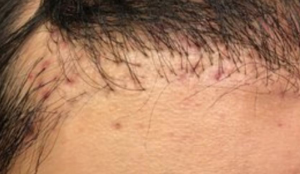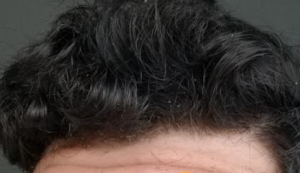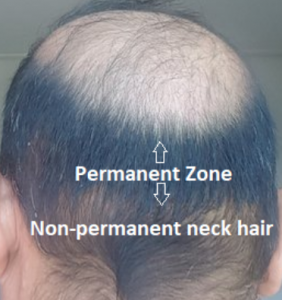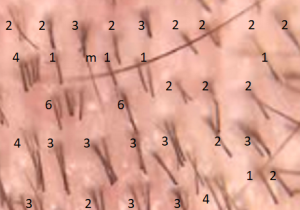From the photo, it is evident that this poor woman experienced a terrible hair transplant result from what is a very straight forward hair transplant in the hands of a skilled and experienced surgeon. The surgeon who did this clearly did not understand the basics of hair transplantation. In away she was lucky as many of the grafts did not grow so the repair will be easier. The repair would be to remove each of the grafts (one by one) and then reconstruct the entire hairline in the proper location with hair placed in the proper direction, burying the scars that remained so that she should end up with a normal looking feminine hairline.
Many doctors are not knowledgeable about hair loss so you should find a doctor who knows about it. To find a good one near you, go to ISHRS.org. Most of these doctors keep up with the advances in the field of hair loss
I started Minox around 2 weeks ago, putting up to 1ml of 5% generic liquid once per day on my scalp. Today, I experienced heart sides (chest pain, tightness in the chest, rapid heartbeat) for the first time after a few days of increased libido and headache.
An incident this afternoon, which I believe might have been a panic attack coupled with dizzyness, led me to look up ‘minoxidil panic attack’ on the internet.
The lower 2% minoxidil has less side effects when used topically, and works well with once a day applications. Yes, there are side effects for everything. You could get in a car accident, but will you stop driving if you have to drive?
I have had hundreds of thousands of readers on baldingblog.com over the years and received significant positive feedback. I believe that when doctors, in particular, open themselves to the public, there is a great value to dispelling myths and bringing the truth forward. Too many people react to hair loss with ignorance. Reddit has also been a significant positive force for educating the public from peers and even people like me. Some great references have appeared and I have found myself educated from being a Reddit participant.
My genetics are solid (everyone has full heads of hair except my paternal grandfather and maternal great grandfather) but, like everyone else, I can’t be sure that I’ll never develop MPB. I’m currently 21. I identify heavily with my hair. Can I rest assured that if I catch MPB in the bud early, I can expect myself to keep my hair as if I never had MPB in the first place if I keep taking it?
Finasteride works well in men under 25. The younger you are, the better it works, especially if caught early. 21 is an age where I would expect good results.
No, this is a very early maturing process that your hairline is undergoing. Most of your juvenile hairline is still present. If your hairline fully matures, it will take on a V-Shape. The hair you lost is just the corners which will eventually go up along with the center hairline. It is just the part of getting older and wiser.
The use of Creatine with or without steroids seems to contribute to hair loss, see here:https://www.ncbi.nlm.nih.gov/m/pubmed/19741313/
I have gone back on finasteride. My first go was 1.25 ED and after three weeks I got erectile dysfunction and numb penis. This time, I switched to 0.25mg EOD and again got side effects after 22 days but they disappeared about 13 days later. Now, i am about 7 weeks in and I have gotten erectile dysfunction again and it has persisted for 3 days. Is it normal to get sides and have them go away, then come back again? Do you think I should keep taking finasteride and see if the side effects go away? I know once I stop the side effects go away. I really want stay in finasteride but im afraid to have an erection that is only 70% full.
Sounds like you are not a candidate for this drug. Taking it long term increases the risk of it becoming a permanent side effect
Here is a picture of the donor area of a man who asked me: How much donor hair do I have? He asks: You have talked about the Donor Bank in your writings, so I would like to know how many grafts are in my Donor Bank and what will be my lifetime supply of grafts for hair transplants in case I should become very bald?
First let’s see where the permanent zone of hair can be found. It is called the permanent zone because even the baldest of men, never lose hair in this zone (see photo below). The zone measured from 2.5-3 inches in height and extends around the entire head from temple prominence on the right side to temple prominence on the left side. We generally assume (safely so) that this hair will always remain (regardless of the balding pattern a man develops). Back in the late 1950, a doctor ‘Orentriech’ discovered that if this hair is moved anywhere on the body, even into a bald area of the scalp, it would grow as it would have grown in its home location in this permanent zone. That is why it is called the permanent zone of hair.
There are two important numbers to determine from the hair in this zone (1) the hair count per follicular unit (these are the groups of hairs that contain one or more hairs each in them) and the thickness of the hair shafts of this permanent hair (never look at the hair you are losing as normal hair as it often gets thinner and thinner). I quantify the thickness of each hair shaft in the permanent zone by feel (experience helps here) or with a micrometer as Fine (~40 microns or less in thickness), Average (~60 microns in thickness) or Coarse (70+ microns in thickness).
I generally take a picture of the donor area with the hairs cut short enough that I can count the number of follicular groups in the field of view and how many hairs are in each group (see below). This field of view of the donor area of one of my patients was taken with a purchased lens as an attachment for my cell phone (https://www.amazon.com/gp/product/B07S5YPPQX?pf_rd_p=ab873d20-a0ca-439b-ac45-cd78f07a84d8&pf_rd_r=CCSSMZGDS79G6AG31TT9) at a cost of $16, something you should consider purchasing.
First let’s do some simple math: There are 34 individual hair groups (shown in the area shown in the photo) which contain from one to 6 hairs each (each are counted and labeled for you). The total hair count in this field is 85 hairs. If we divide the number of hairs by the number of groups 85/34= 2.5 hairs per Follicular unit (a Follicular Unit is essentially what we call a Graft in a hair transplant surgery). The average Caucasian has 2.2 hairs per Follicular Group so the man shown here has a hair count that is 13% higher than average. I can tell from this number that this man has 125,000 birth hairs on his head regardless of how much hair he has already lost. I felt his hair for thickness and measured it. It measured 60 microns which is essentially an average weight hair.
Now let’s look at more detail at this picture. There is a single hair shown that I labeled ‘m’ for a miniaturized hair. So this man had approximately 1% miniaturized hairs. The number of miniaturized hairs can be as high as 20% and the donor area is still considered healthy. As we get older (into your 50-90s) these hair groups may drop hairs so that the count could be slightly lower and the hairs that we often drop will often be miniaturized before they fall out. Everyone experiences hair changes with age, as donor area hairs may get ‘finer’ so that they contain less hair bulk per hair shaft. If these hairs are used for a hair transplant, whatever happens in this permanent zone, will happen in the hair transplanted hairs as well.
The calculations of his total donor bank supply is a bit more complicated. Each person has a fixed number of Follicular units (about 50,000 for an average sized head) and the hairs in these follicular units can be counted. Generously assuming that the size of the donor area is between 20-25% of the total hair baring scalp (let’s use 25% as a number for calculations here), this patient has 31,250 hair in his permanent zone or 12,500 follicular units (grafts) of which he can transplant theoretically no more than 60% of these hairs (follicular units or grafts). The 60% number is based upon an average hair count, but because this man has 13% more hair, he can actually move 13% more grafts bringing his total available lifetime hair to 7,500 * 1.13 = 8,475 grafts available during his lifetime.
Experienced surgeons like me who have been measuring hair densities since I first entered the practice and defined it in the literature, have learned when they can increase even this number safely. This is where surgical judgment comes in. I would like you to try to make this important assessment of your Donor Bank so that you will be able to (1) test the doctor’s knowledge of what he says about your donor supply, (2) be confident that your donor quality and quantity is adequate to meet your short and long term hair transplant needs.
I’m currently only 17 and I noticed recently that my hairline is starting to go. It’s not so noticeable at the moment, but does bother me a bit. I’ll drop some pictures so you can get an idea. I have no idea what to do right now and I want to stop it and regrow to make it thicker in the areas in a bit thin. I currently only take a multivitamin everyday since that’s all I feel safe taking until I get some solid advice. I know about a derma roller, finasteride, and minoxidil but I’m not sure what I need to take. Please let me know!
First I would advise you to find a good caring doctor who will build a Master Plan with you to allow you to maintain your hair for many years. Getting a HAIRCHECK test is a good thing because it will quantify the amount of hair you have lost so far. Things like the Dermaroller with minoxidil works well. So does finasteride but make sure that you really have hair loss and are at the beginning stages of hair loss before you commit to these treatments which have to be maintained.
If you are going to stop it, then stop it when the decision is made. Tapering it off, will give your finasteride dependent hair more time to hold, but the inevitable will happen if the hair is finasteride dependent.
NO, hair is not alive so cutting it does not damage the hair shafts under the skin where new hair is generated.
I originally answered this as yes and that if he had a few sexual side effects in the past, he might have them now. The readers was combative saying: How can you make such a powerful statement? On which facts are you basing it ? On the M.D. at the back or ?
There are tons of scientists, doctors, studies and reports that say the chances in getting sides are getting bigger with every pill you take, with every year you age!
I don’t want to be rude, I’m sure you have your experiences, but do you know the person in cause, his medical history, etc ? Have you seen his blood work or something at least ?
Also, are you a “future reader”, or a doctor ?
And also, if he takes it tomorrow and after a year or maybe less or more he comes and complains about sexual sides, are you gonna stick with this statement or are you gonna tell him “it’s just in his head” ?
With age, more and more men normally develop ED. It is believed that 30% of men who are 30 have some degree of ED, 40% of men who are 40 have some degree of ED, 50% of men who are 50 have some degree of ED. With that said, the longer you take finasteride, you might fall into the normal changes that occur on men’s sexual function as they age.
Nice comment and congrats. Many women with hair loss are not good surgical candidates, but it seems that you were. I would caution many women reading this post to be careful when considering a hair transplant, for hair loss in the female is not like male hair loss.
Page 3 of 7





